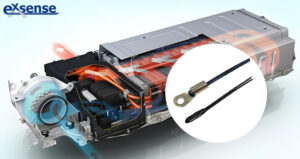High Reliable NTC Temperature Sensor for Automotive Energy Storage BMS Modules
 As a core technology of energy vehicle powertrains, the Battery Management System (BMS) safeguards battery stability, extends lifespan, and ensures vehicle safety. The NTC temperature sensor—an indispensable sensing component in BMS—performs critical functions including battery temperature monitoring, thermal management compensation, and fault diagnosis. Leveraging its highly reliable thermal sensing and feedback capabilities, the NTC sensor establishes a robust safety barrier for battery thermal control systems, enhancing operational stability and durability while driving technological evolution in electric vehicles.
As a core technology of energy vehicle powertrains, the Battery Management System (BMS) safeguards battery stability, extends lifespan, and ensures vehicle safety. The NTC temperature sensor—an indispensable sensing component in BMS—performs critical functions including battery temperature monitoring, thermal management compensation, and fault diagnosis. Leveraging its highly reliable thermal sensing and feedback capabilities, the NTC sensor establishes a robust safety barrier for battery thermal control systems, enhancing operational stability and durability while driving technological evolution in electric vehicles.
Ⅰ.BMS Operating Principles
The core function of the Battery Management System is to comprehensively monitor, process comprehensively, and control battery pack data, thereby optimizing performance and ensuring safety. First, BMS utilizes high-precision NTC temperature sensors to capture real-time, multi-dimensional data (voltage, current, and temperature) from individual cells. Subsequently, advanced algorithms analyze this data.
Ⅱ. Working Principle of NTC Temperature Sensors
Fundamentally, an NTC thermistor-based probe, this sensor exhibits an exponential decrease in resistance as temperature rises (Negative Temperature Coefficient effect). It is typically fabricated by sintering a mixture of two or three metal oxides within a clay-like fluid medium at high temperatures, forming a dense ceramic structure.
In practical applications, the correlation between resistance and temperature under constant power enables precise temperature measurement: resistance changes are measured to derive corresponding temperatures, facilitating closed-loop thermal control. This characteristic establishes NTC sensors as core components in temperature monitoring systems.
Ⅲ. AFE Chips: Temperature Acquisition
The Analog Front End (AFE) serves as the bridge between analog temperature sensors and digital signal processing systems. As a critical BMS component for cell safety monitoring, AFE chips integrate multi-channel sampling to acquire key parameters (cell voltage, temperature) simultaneously. Their architecture comprises balancing switches, communication modules, and acquisition modules—the latter including analog multiplexers (MUX), AD converters (ADC), and reference sources (REFERENCE), as detailed in the functional diagram:
During data acquisition, analog signals undergo selective sampling via MUX, conversion to digital signals through ADC, and transmission to the central controller (MCU) via interfaces (SPI/I²C/UART). The MCU calculates core parameters, such as State of Charge (SOC) and State of Health (SOH), in real-time. Additionally, AFE dynamically monitors battery conditions by adjusting parameters to maintain optimal operation, delay aging, and ensure EV stability. Key functions include:
- Voltage Detection Channels: Directly acquire cell voltage data while performing cell balancing to maintain voltage uniformity.
- NTC Sensor Interface: NTC thermistors—core components for lithium battery thermal management—precisely capture temperature fluctuations during charging/discharging. Sensors deployed in thermally sensitive zones convert temperature signals to voltage for AFE processing.
- GPIO Connectors: Provide expandable interfaces for cooling systems, contactor controls, heaters, and other devices, supporting firmware-upgradable functionality.
- ISO-SPI Channels: Establish high-speed isolated communication between sensor circuits and control units, ensuring data reliability and security.
- AFE Power Module: Supplies stable voltage, typically drawn directly from the battery pack.
Ⅳ.NTC Sensor Selection and Placement for BMS
Sensor Selection must consider core parameters:
- Temperature Range: Must cover extreme conditions (e.g., fast-charging/high-temperature environments).
- Accuracy: Prioritize tighter tolerances (±0.5% or better) for high-precision demands.
- Response Time: Opt for faster-response sensors in dynamic thermal environments.
Placement Strategy requires meticulous planning based on:
- Battery pack topology
- Thermal management strategy
- Heat dissipation characteristics
- Avoid positioning near cooling paths (fans/cooling plate edges) to prevent undervalued readings and excessive embedding depth that impedes signal transmission. Optimal placement ensures precise real-time monitoring of battery cells and critical zones (cell gaps/busbar connections), delivering reliable data for BMS thermal decisions.
Conclusion: The synergy between BMS and NTC temperature sensors forms the core perception and control unit for battery management in energy vehicles. Their coordinated operation enables 24/7 monitoring, dynamic assessment, and precise regulation, fortifying safety (overtemperature alerts/thermal runaway prevention) while extending battery service life.














.jpg)
